Physical Address
304 North Cardinal St.
Dorchester Center, MA 02124
Physical Address
304 North Cardinal St.
Dorchester Center, MA 02124
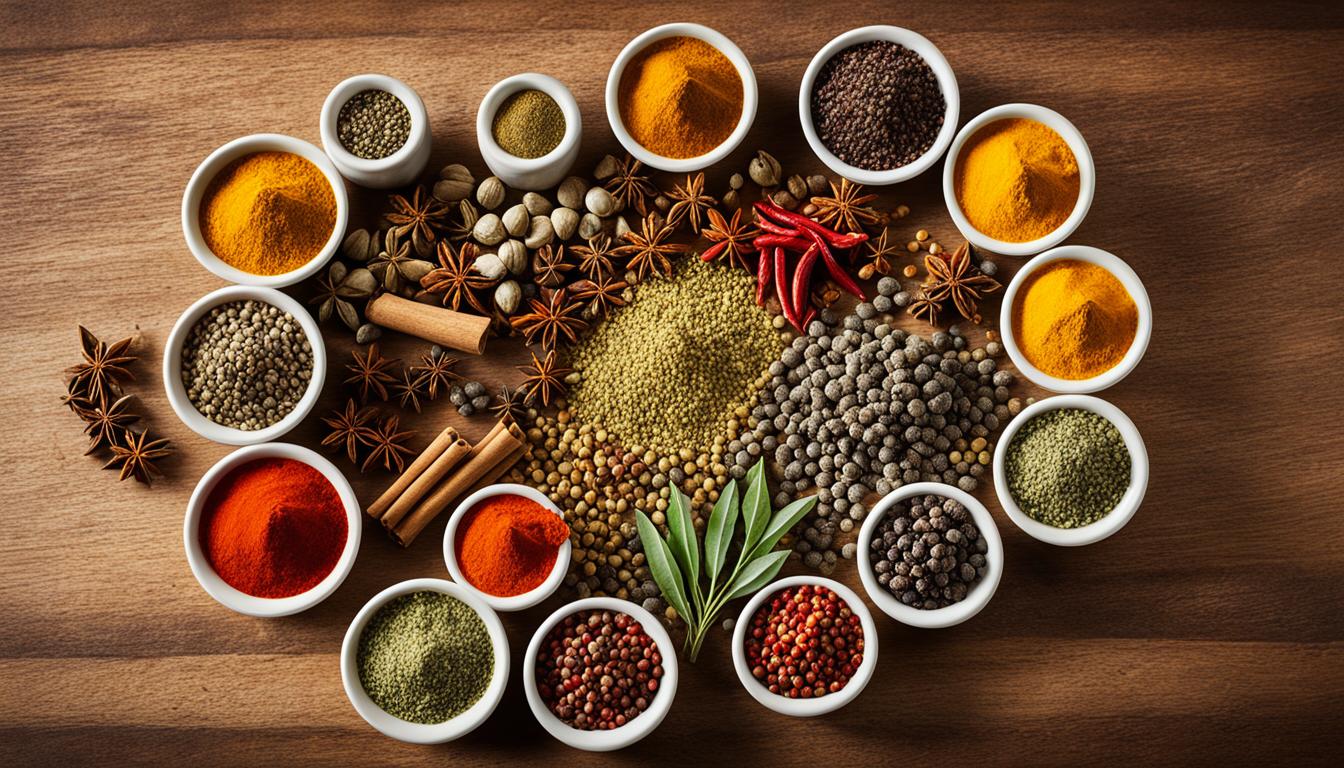
Unlock the art of flavorful dishes with expert tips on how to properly season your food. Elevate your cooking with techniques for salt, pepper, herbs, and spices.
Seasoning your food well can lift any meal from good to great. It’s more than just salt and pepper. It’s an art that makes simple foods into culinary wonders. This guide will show you how to use salt, pepper, and other spices to make your food amazing.
Have you ever cooked something that just didn’t taste right? More often than not, the fix is adjusting the salt techniques. From salt crystals to sprinkling some cheese, adding salt is key for a dish to taste great. It’s all about the flavor profiles and knowing when to add the salt to make your food perfect.
Salt stands out as a key ingredient that brings out the best flavors in food. It can make bland foods tasty and highlights the natural taste in each bite. Whether you’re salting pasta water or vegetables, using salt right makes every mouthful delicious.
Seasoning at every stage, not just at the end, creates a dish bursting with flavor. Add salt from the start to the very finish on your dishes. This method makes sure every ingredient is as flavorful as can be.
For the last step, a touch of special salt or a grind of pepper finishes the dish perfectly. This small move can turn a nice dish into a sensational one. It adds both flavor profiles and a beautiful look to your meal.
| Salt Type | Sodium per Teaspoon |
|---|---|
| Table Salt | 2325 mg |
| Diamond Crystal Kosher Salt | 1120 mg |
| Diamond Crystal Sea Salt | 2160 mg |
| Morton Kosher Salt | 1920 mg |
| Morton Sea Salt | 2240 mg |
To get a steak that tastes like it’s from a restaurant, you need to season it just right. The secret source talks about how important it is to season your steak well to make the most of its flavor.
The best salt to use is kosher salt, not table salt or iodized salt. Kosher salt has bigger crystals, which means it sticks better on the steak’s surface. This leads to a tastier and more even seasoning.
Both sides and the edges of the Steak should be covered with salt and black pepper. Doing this means every part of the steak gets flavored. It makes a mix of Pepper Combinations blend perfectly with the meat.
When the steak is done cooking and has rested, top it off with flaky sea salt. Maldon or Jacobson salts are great choices. This last step gives the steak a nice texture and makes its natural flavor even better.
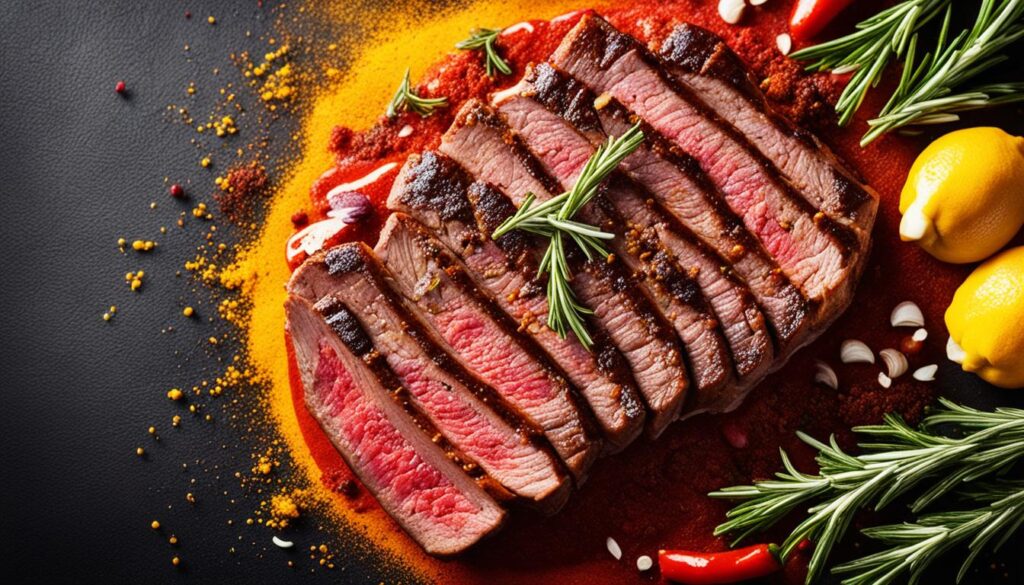
The Blackstone griddle is loved for its many uses. To work well, it must be seasoned. Seasoning means putting a layer of oil on it to stop rust, help food not stick, and spread heat right.
Seasoning is key for a few big reasons. The oil keeps the griddle from rusting, so it lasts longer. And it helps cook your food more evenly. Plus, it makes the griddle easier to clean because food doesn’t stick as much.
Seasoning is easy and takes about an hour. First, clean the griddle with warm, soapy water to get rid of leftover stuff. Then, heat it up and add a bit of oil on it. Heat it until the oil smokes. Do this a few times to get a good, dark layer on the griddle.
Keeping your griddle seasoned well is important. Use mild soap on it sparingly because too much can take the seasoning off. If you see rust, mix salt, soap powder, and water to clean it. After that, season it again with oil. Use your griddle often. And add more seasoning when it needs it. This way, your Blackstone griddle will always be ready for great cooking.
Seasoning your food right is key to making tasty dishes. It’s not just about salt and pepper. For anyone cooking at home, learning the proper Seasoning Techniques and Flavor Optimization can greatly improve your meals. Let’s cover the crucial Cooking Tips needed to make every bite flavorful.
First, let’s talk about salt. It brings out the best in flavors. Kosher salt is top choice for most. It’s important to add salt throughout cooking, not just at the end. This way, your dish tastes great all the way through.
Next is freshly ground black pepper. It really levels up your food’s taste and smell. Use it on all protein cuts. A good amount of salt and pepper will ensure every bite is delicious.
Spices and herbs are also crucial for taste. But remember, they can go bad. Swapping them out every nine months keeps your dishes full of flavor. Cooking them in fat brings out their best, especially for hard herb ground spices.
Don’t forget about balance in your flavors. Things like lemon or vinegar can really make a dish pop. And always taste your food as you cook. It helps you adjust the seasoning just right and catch any flavor issues.
Summing up the crucial parts of seasoning:
By getting these
Seasoning Techniques
and
Cooking Tips
down, you’ll start making meals that look great and taste even better.
Flavor Optimization
is your new best friend in the kitchen. So, learn to season like a pro and watch your dishes shine.
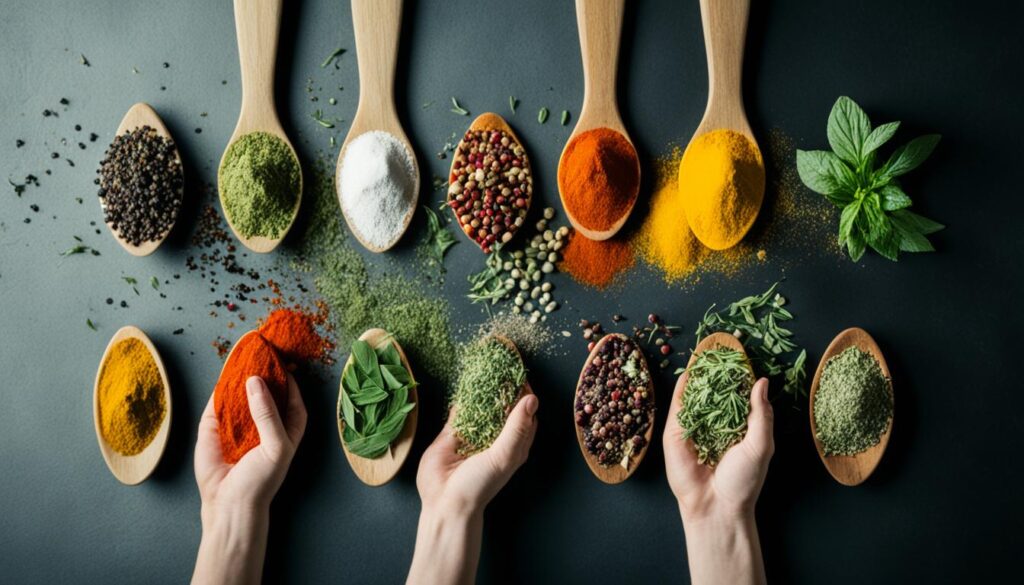
Seasoning your Blackstone griddle starts with knowing about oil smoke points. The smoke point is when oil starts to smoke and break down. This can change your food’s taste and safety. For seasoning, choose oils like flaxseed, vegetable, or avocado. They have high smoke points and work well at high heat without smoking.
The oil used for seasoning should easily form a strong, non-stick layer. This happens when the oil bonds to the griddle. Oils with high smoke points ensure this process works well, keeping your griddle in top shape.
| Oil | Smoke Point |
|---|---|
| Safflower Oil | 510°F/265°C |
| Rice Bran Oil | 490°F/260°C |
| Light/Refined Olive Oil | 465°F/240°C |
| Soybean Oil | 450°F/230°C |
| Peanut Oil | 450°F/230°C |
| Clarified Butter | 450°F/230°C |
| Corn Oil | 450°F/230°C |
| Sunflower Oil | 440°F/225°C |
Choosing the right oil for seasoning means looking at its smoke point. This way, you prepare your griddle for intense cooking. It will be set for frying, sautéing, and searing.
Maintaining your Blackstone griddle is key for it to last long and work well. Regular cleaning and re-seasoning are key. The third source has lots of tips on this.
If you see Rust Removal on your griddle, deal with it before re-seasoning. The best way is to use warm, soapy water and a grill brick or steel wool. This will get rid of any rust and food bits.
For tougher rust, mix salt, soap powder, and water. Gently scrub the rust with this solution until it’s gone.
Seasoning your Blackstone griddle takes about an hour. You need to put a thin coat of oil all over it and repeat a few times. Use oils like flaxseed, vegetable oil, or special oils designed for griddles. They work best.
By keeping your griddle clean and seasoned, it will last for many more cooking adventures.
Seasoning is key to making ingredients taste better. It works whether you’re cooking Vegetables, Meats, or Pasta and Grains. By mastering seasoning techniques, home chefs can make their meals more delicious and well-rounded.
With Vegetables, adding salt and flavors early is crucial. This means salting the water for pasta and seasoning each step, like sautéing or grilling. Adding seasonings as you cook helps blend the flavors well.
There’s a big question in Meats: to season early or right before cooking? Some chefs prefer to season just before, while others swear by an earlier seasoning. Tests showed seasoning 24 hours in advance makes chicken and some steaks tastier. But, fresh seasoning on pork roasts before baking makes them juicier and more appealing.
For Pasta and Grains, adding salt in the water is crucial. It helps the ingredients taste better from the inside out. Then, adding spices and herbs to the finished dish can further make it tasty and well-balanced.
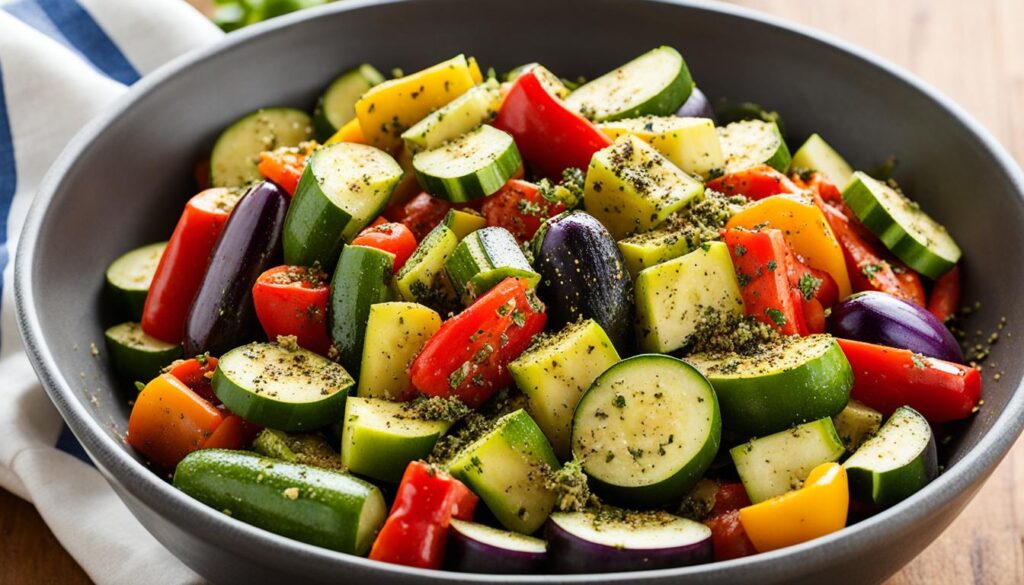
Seasoning is key to making dishes tasty and balanced. Chefs use a special method. They start with base aromatic ingredients. Then, they add main flavors and end with taste-enhancing ingredients. This makes the dish’s taste stand out.
Seasoning blends add layers of flavor. They can make dishes more interesting. For example, European cooking might use celery, carrots, and onions with basil, oregano, and thyme. This makes French, Spanish, Greek, or Italian dishes unique. Thai holy trinity, which includes galangal, Thai lime leaves, and lemongrass, does the same for Thai food.
Every culture has its unique seasonings. This creates its own flavor profiles. Knowing the seasonings helps home cooks. They can mix these seasonings to make their dishes even better. Exploring these cultural influences opens the door to a variety of flavors in cooking.
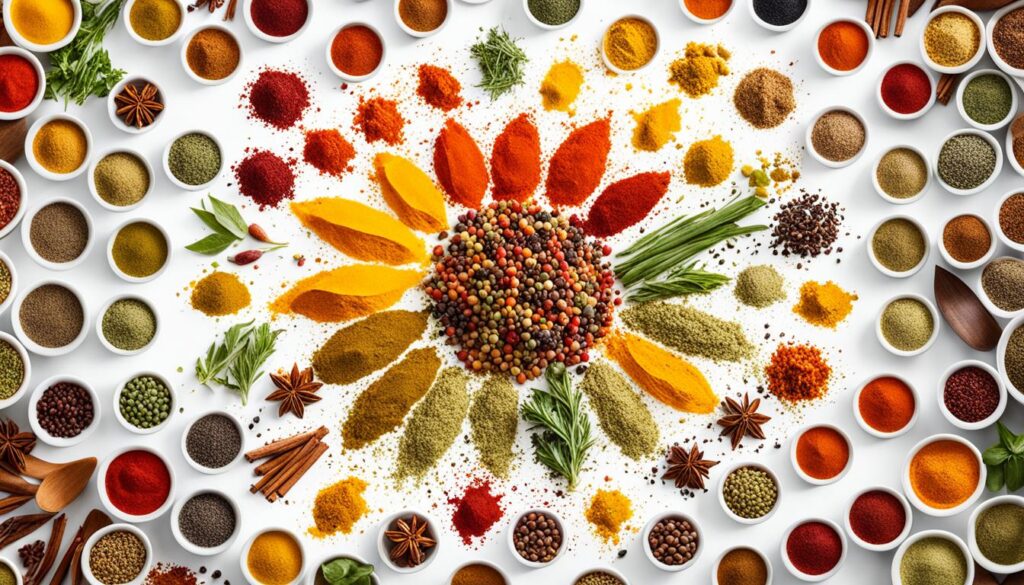
Seasoning your food well is key for any home cook. It can transform a simple meal into something extraordinary. Paying attention to seasoning tips, ratios, timing, and adjustments is essential for great dishes. This applies whether you’re cooking a quick dinner or a special celebratory meal.
“Less is more” when seasoning is a wise saying. Start with just a little salt, pepper, and spices. Then, adjust to what tastes good to you. Keep in mind that Morton kosher salt is saltier than Diamond Crystal. So, you’ll need less of it. Ground spices lose their flavor after about nine months. So, replace them often to keep your meals tasty.
When to season and the heat level matter for your dish’s taste. For foods that cook slowly, like stews, season early. This lets flavors blend well.
For dishes that cook fast, like stir-fries, season at the end. This keeps flavors fresh. Whole seeds and nuts need light toasting to release their taste. Ground herbs and spices like dried basil should be added earlier while cooking.
Taste as you cook to fine-tune your seasonings. Understanding what your dish needs can lead to a perfectly balanced meal. Salt and pepper are vital throughout the cooking process. They contribute about 75% of the overall seasoning.
As we wrap up our journey through seasoning, we see it’s vital for tasty meals. Salt, pepper, herbs, and spices make food stand out. They give every meal an exciting taste.
We’ve talked a lot about the importance of seasoning. Salt brings out the best in ingredients. Seasoning rightly can make veggies, meats, and pasta pop. It’s a way to add unique flavors from around the world to your dishes.
The real secret to great flavor is knowing how to season. We want you to love trying new combos. This will help you make mouthwatering meals at home. So, get creative with your seasonings and enjoy the flavorful journey!